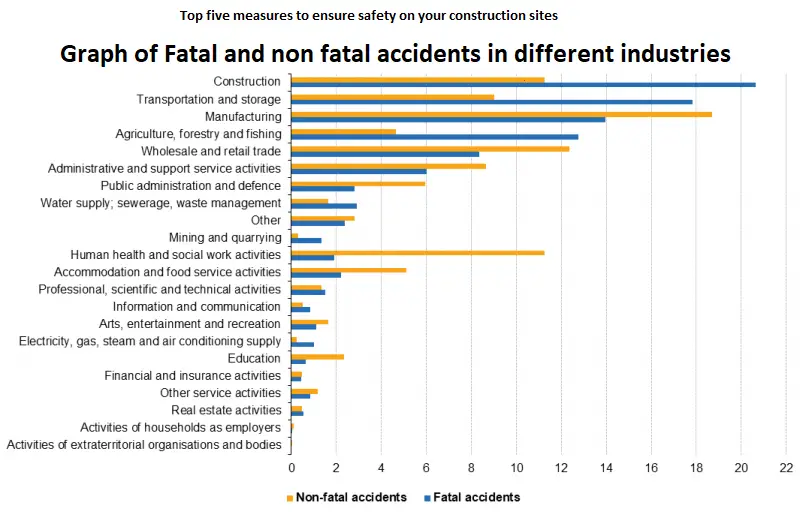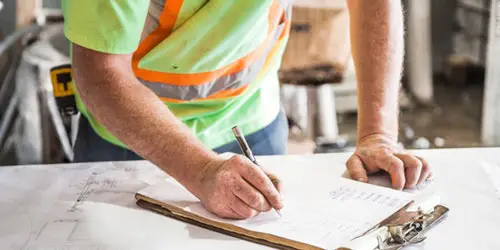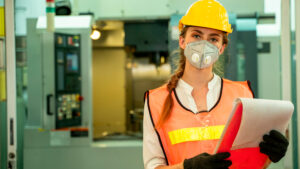Top five measures to ensure safety on construction sites

Top five measures to ensure safety on construction sites. The construction industry is one of the most dangerous working environments. However, using the right asset management software is a very affordable way to improve the safety and security of construction sites, while providing you with other benefits.
The nature of the work undertaken on a construction site (for example, working at height, with electric current, or even moving large volumes of materials) and the tools and equipment used are a source of serious and even fatal accidents. As a result, the cost of an investment that allows you to greatly improve the safety and security of your construction site is significantly lower than the cost of a severe accident.
In addition, ensuring the safety of its workers on the site is a legal obligation for any employer to ensure the safety and protect the physical and mental health of workers.

Consequences of an accident on site
Unfortunately, site safety is an element that still has potential for improvement. Indeed, the construction sector records most fatal accidents in the workplace, as well as a high rate of non-fatal accidents:
On-site, the risk of accidents is omnipresent. Every day, workers expose themselves to significant risks to their health and safety. The consequences of these accidents can be very serious, ranging from a minor injury to a permanent physical disability, even the death of the worker. But the consequences of on-site accidents do not end there. They can be:
Direct – injury/death of one or more workers, property damage, time lost on a project, etc.
Indirect – staff shortages, lawsuits, delays, budget overruns, cost trends, insurance premiums, management time required, etc.
In the long run, these tragic events can also damage the image and reputation of the company, cause loss of confidence among workers and customers, as well as lead to strikes.
Fortunately, there are solutions that allow you to limit these risks and consequences. The investment corresponding to the implementation of appropriate safety and security measures will probably be much lower than the cost of a serious accident. This is why we are sharing our 5 best practices with you to help ensure safety and security on your site and thus avoid the devastating consequences of an accident.
1. Risk identification
Workers entering the site must be fully aware of the possible dangers. This means that they must be able to identify the risks present in their workplace and know how to prevent them.
In the United States, the Occupational Safety and Health Administration (OSHA) has identified the ten most common activities involved in reported construction accidents. Scaffolding is the number one cause of accidents and the danger arises when scaffolding is not set up or used correctly. OSHA estimates that better protection of workers from such accidents would prevent about 4,500 injuries and 50 deaths each year.
It is the foreman’s responsibility to ensure that each worker is fully aware of the hazards they face. Indeed, the foreman must ensure that each worker is fully trained to perform the work, without endangering his safety or that of other workers. If a worker is not fully trained or aware of the risks, he should be refused access to the site.
2. Safety training
Although workers can learn many skills by working directly on job sites, they need to acquire safety knowledge before entering them. In addition, the learning does not end with a single training. Indeed, even the experienced worker must regularly update his knowledge of safety on construction sites.
Jobsite safety training teaches workers how to identify and prevent hazards (for example, the use of fall protection, or the proper use of scaffolding, ladders, etc.). It also reiterates the importance of setting and respecting certain safety rules. It is the responsibility of the foreman and the construction company to ensure that workers cannot access a site without having received adequate safety training. Considering the high risks and costs of accidents on a construction site, providing training for all workers on site not only saves a company in terms of costs, but also in terms of reputation and reputation.
3. Equipment on site
Each worker must be able to perform a task with the correct equipment and in good condition. Therefore, a construction company has a responsibility to provide the right equipment for the job and to ensure that it is well maintained.
This means that all tools, equipment, materials, etc. must be identified and inventoried. Inventory control can be put in place to ensure that equipment is not lost or stolen, or to help plan necessary maintenance and replacement. In addition, ensuring that equipment is stored in good conditions helps improve overall safety in the workplace. Finally, knowing exactly who is using the equipment at any given time is also a good way to reduce the risk of an accident.
Equipment maintenance, location, and liability can be controlled using a single software package, suitable for the construction industry. The latter helps provide you with a clear overview of the use of this equipment on site.
4. Appropriate supervision
Although all workers should be able to identify and avoid hazards on construction sites, the reality is much more complex. For example, a worker may have a moment of inattention, feel that their way of doing things is better, or simply not be fully aware of the danger.
Therefore, each job site must be supervised by an accomplished foreman with genuine supervisory expertise. The foreman must be able to ensure that all safety measures are followed, without exception.
5. Effective communication
Maintaining an optimal flow of information is essential to avoid the occurrence of accidents on construction sites. This information relates in particular to the status of a worker, in order to ensure that only authorized persons enter the site. They may also relate to the need to maintain equipment and therefore to ensure that it remains in satisfactory condition.
In addition, it should be made clear to everyone on site that safety is a top priority. For example, assigning responsibility for equipment to one person helps make workers aware of their obligations regarding the correct use of equipment.
Overall, it is essential to keep track of everything that happens on the site and pass this information on to the office to ensure that all security measures are followed.
The cost of implementing suitable safety and security measures is much lower than the cost of an accident. Due to the high risk of accidents in the construction sector, it is essential to prevent them by allocating an appropriate budget for the deployment of such measures.
Conclusion
All sources of potential danger on construction sites must be identified and concrete actions must be put in place to prevent them. To achieve this optimally, a minor investment in suitable construction software is your best option. Indeed, such software allows you to ensure the administrative compliance of workers, the proper maintenance of equipment, the efficient flow of information, etc. In the end, you will benefit from a clear and precise overview of everything that is happening on the site in relation to the safety and security of your workers, which is a real priority for a construction company.
Would you like to know more about how we can help you improve safety on your construction sites?







